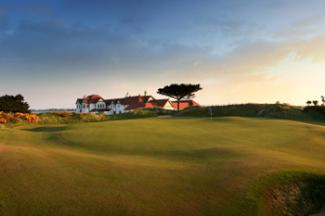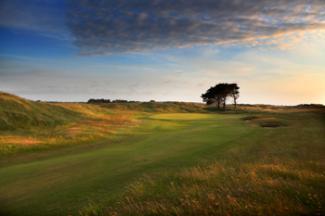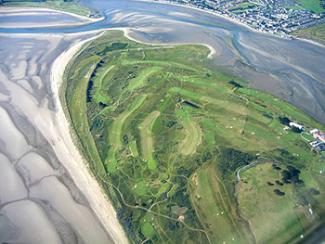Featured Golf News
Everything Great about Irish Golf Found at Portmarnock
To most Americans and Europeans, green symbolizes nature and life; to me, the color means friends and good times. So it seems appropriate that on the morning after I played famed Portmarnock Golf Club, one of the top courses in Ireland and known worldwide, green was what I remembered most.

18th Green at Portmarnock GC with Clubhouse
That may be because of the over-the-top treatment I received as a guest of the club, or it was due perhaps to the great round I enjoyed on the Old Course at Portmarnock, whose red and blue nines were designed by the club's founder, William Pickeman, and date back to 1894. There's also a third nine (yellow) fashioned by Fred Hawtree in 1971, which has characteristics similar to the original course.
Located just north of Dublin in the hamlet of Portmarnock on the western coast of Ireland, the course and its grounds occupy some 500 acres of a small peninsula wedged between the Irish Sea and a tidal inlet north of Dublin Bay.
The isthmus was once owned by whiskey distiller John Jameson and his family (they had a home and an unrelated private nine-hole course on the property's north side), and originally consisted of just nine holes, with another nine added two years after the club was founded.
The club offers splendid views of Ireland's Eye (a small island near Dublin Bay) and, when looking inland, of the country's capital city. But don't get distracted -Portmarnock GC (not to be confused with the Portmarnock Hotel & Golf Links, a 1995 design by Bernhard Langer) demands full attention on every shot.

Portmarnock Golf Club
Never a Dull Moment
The par-72 layout is carded at 7,466 yards from its back set of three tees. But Portmarnock's appeal is not length - it's the course's variety that makes it so memorable.
Surrounded by water on three sides and laid out in a serpentine manner which eventually leads back to the clubhouse, Portmarnock has no two successive holes running in the same direction. When the wind is up, all bets are off trying to tame this beast. The routing winds between dunes and involves a handful of elevated tees, some blind approaches and twisting doglegs.
The current layout follows the original course, although it's been lengthened considerably over the decades. The only significant change was the insertion in 1927 of a now-famous par-3, the 204-yard 15th, which shifted the original 15th to a hole ahead.
In general, it's recommended to drive straight here. Though the narrow, dimpled fairways curl between thick fescues and are demarcated by deep pot bunkers, the landing areas are generally in full view from the tee and mostly flat. The bounces are usually predictable and the hazards stern, but they are not impossible to recover from unless you're deep in the treacherous and gnarly fescue and marram grasses bordering the holes.

Portmarnock GC's 4th Hole
In the past decade, contemporary golf architect Martin Hawtree (relative of Fred) has changed a few holes. He reworked the 417-yard opener; it now runs along Baldoyle Estuary, with a new putting surface that requires a brave and precise approach.
After the first, the course meanders through dunes, deceiving golfers into a false sense of security with a seemingly gentle visage. Portmarnock has only three par-3s (the 184-yard seventh, 177-yard 12th and the 15th). There's also a stretch of mid-length par-4s at Nos. 1-5, with another batch in the middle of the round.
The downwind, 411-yard par-4 14th, which plays into a small tabletop-type target that is heavily bunkered at the front, is another standout. English professional Henry Cotton, who won five major titles including three British Opens, regarded Portmarnock's 14th as the best hole in all of golf.
Holes 15-17 at Portmarnock GC are considered among the finest in the Emerald Isle. The 15th lies directly along the shore, and from its elevated tee the proper shot must arc over thick rough to a low-lying green surrounded by three pot bunkers and flanked left by a deep recess. Immediately right of the green are a thick hedge and marram grass. Factor in the prevailing head winds, and this is a very daunting tee shot.

The Famed 12th at Portmarnock GC (Photo by Aidan Bradley)
At the start of the 577-yard par-5 16th, the fairway looks like a mowed path in a tall-grass field. The landing area is sloped, but never for long in the same direction, and is later bisected by a three-foot-high ridge. The putting surface slopes severely from back to front and is well-bunkered.
The brutal 472-yard 17th is a straight par-4 that usually plays into a prevailing wind. The approach, usually with a hybrid or fairway metal, is to a green partially obscured by a right-hand bunker and snaggy grass.
Like all true links, Portmarnock was designed by Mother Nature, though what makes it a classic is how Pickeman crafted - and later architects refined - cleverly consistent holes across the terrain's low-lying features.
A true test, Portmarnock GC has hosted 19 Irish Opens (including the first in 1927), a Walker Cup, Canada Cup (World Cup), Irish Amateur championships and numerous other top-flight amateur and professional events. In 2012 it hosted both the St. Andrews & Jacques Leglisť Trophy competitions.

Aerial View of Portmarnock
Visitors and groups will greatly enjoy the traditions and wonderful atmosphere that are hallmarks of Portmarnock. It doesn't overwhelm with pretty views, huge dunes or massive pot bunkers. Instead, it boasts one demanding hole after another, each with a different strategy because of the ever-changing winds and varied directions of play.
A visit to Portmarnock GC offers a truly unique experience and a superior taste of Irish golf. For more information, see www.portmarnockgolfclub.ie/.
Steve Habel is a freelance writer contributing Cybergolf news stories, features, equipment and book reviews and personality profiles from his base in Central Texas. He also works as a contributing editor for Horns Illustrated magazine, a publication focusing on University of Texas sports, and is a contributing writer for Golfers' Guide and Golf Oklahoma magazine, Texas Links magazines and Golfers Guide. Habel's main blog (www.shotoverthegreen.blogspot.com) features news on golf and the Longhorns, and another (www.checkinginandplayingthrough.blogspot.com) chronicles his many travels, including playing more than 600 golf courses since 2008. Habel is a member of the Golf Writers Association of America and the Texas Golf Writers Association.
Story Options
 |
Print this Story |
